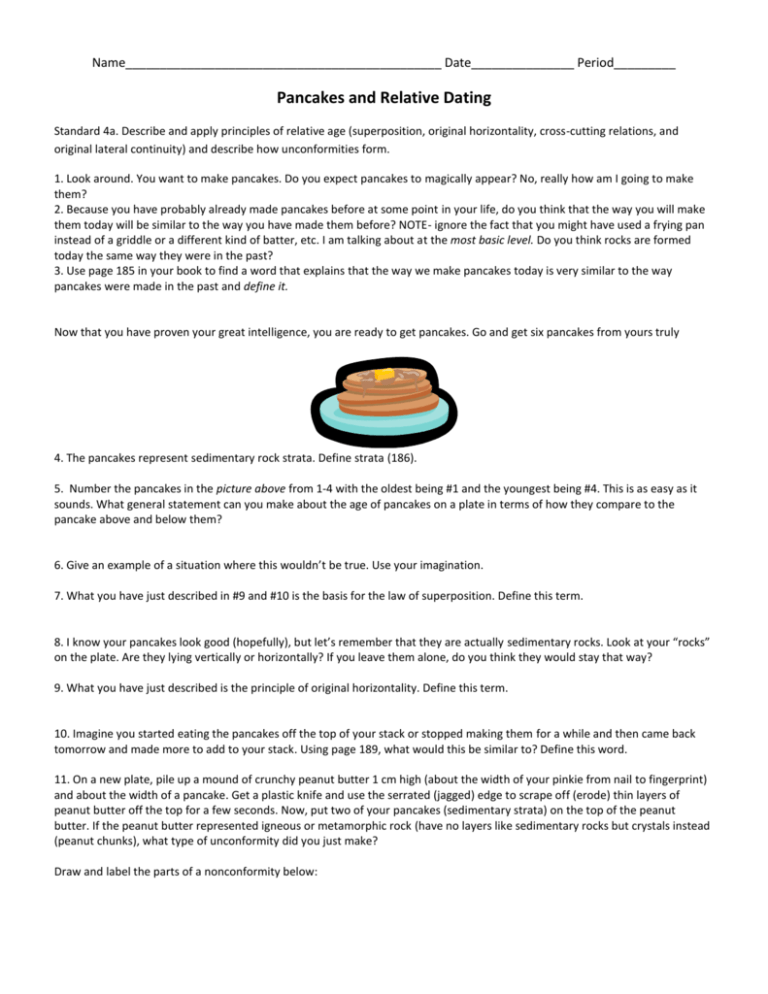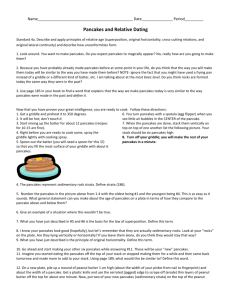Name______________________________________________
advertisement

Name______________________________________________ Date_______________ Period_________ Pancakes and Relative Dating Standard 4a. Describe and apply principles of relative age (superposition, original horizontality, cross-cutting relations, and original lateral continuity) and describe how unconformities form. 1. Look around. You want to make pancakes. Do you expect pancakes to magically appear? No, really how am I going to make them? 2. Because you have probably already made pancakes before at some point in your life, do you think that the way you will make them today will be similar to the way you have made them before? NOTE- ignore the fact that you might have used a frying pan instead of a griddle or a different kind of batter, etc. I am talking about at the most basic level. Do you think rocks are formed today the same way they were in the past? 3. Use page 185 in your book to find a word that explains that the way we make pancakes today is very similar to the way pancakes were made in the past and define it. Now that you have proven your great intelligence, you are ready to get pancakes. Go and get six pancakes from yours truly 4. The pancakes represent sedimentary rock strata. Define strata (186). 5. Number the pancakes in the picture above from 1-4 with the oldest being #1 and the youngest being #4. This is as easy as it sounds. What general statement can you make about the age of pancakes on a plate in terms of how they compare to the pancake above and below them? 6. Give an example of a situation where this wouldn’t be true. Use your imagination. 7. What you have just described in #9 and #10 is the basis for the law of superposition. Define this term. 8. I know your pancakes look good (hopefully), but let’s remember that they are actually sedimentary rocks. Look at your “rocks” on the plate. Are they lying vertically or horizontally? If you leave them alone, do you think they would stay that way? 9. What you have just described is the principle of original horizontality. Define this term. 10. Imagine you started eating the pancakes off the top of your stack or stopped making them for a while and then came back tomorrow and made more to add to your stack. Using page 189, what would this be similar to? Define this word. 11. On a new plate, pile up a mound of crunchy peanut butter 1 cm high (about the width of your pinkie from nail to fingerprint) and about the width of a pancake. Get a plastic knife and use the serrated (jagged) edge to scrape off (erode) thin layers of peanut butter off the top for a few seconds. Now, put two of your pancakes (sedimentary strata) on the top of the peanut butter. If the peanut butter represented igneous or metamorphic rock (have no layers like sedimentary rocks but crystals instead (peanut chunks), what type of unconformity did you just make? Draw and label the parts of a nonconformity below: 12. Take three pancakes and cut them in half. Using the right-side half, tilt them vertically like in the picture of angular unconformities, and then stack four uncut pancakes on top. Draw and label the parts of an angular unconformity below: 13. Using the three remaining pancakes, steal and eat the one in the middle. How is this like a disconformity? Draw and label the parts of a disconformity below. 14. Put your four pancakes on a plate. Cut them at angle like in the picture on page 190. Which is older, the pancakes or the cut? 15. What do the pancakes represent? What does the cut represent? 16. Make an igneous intrusion by poking a hole that runs through your “rock layers” and with a pretzel stick. You can make the hole at any angle or direction. Which is older, the rock or the igneous intrusion? 17. Define the law of crosscutting relationships. 18. While using the illustration from page 190 to order the following from oldest to youngest- the igneous intrusion, layer A, layer B, layer C, layer D, and the fault. The principle of lateral continuity states that layers of sediment initially extend laterally (side to side) in all directions; in other words, they are laterally continuous. As a result, rocks that are otherwise similar, but are now separated by a valley or other erosional feature, can be assumed to be the same rock layer. Layers of sediment do not extend indefinitely; rather, as the amount of sediment lessens away from the source, the layer of that material will become thinner. 20. Draw an example of what you think this might look like. Use a valley to separate the layers. Use colors to show that they layers that are separated are still the same rock formation. Hint- think of the Grand Canyon. 21. How could you do this with pancakes? 22. How is the relative age of a rock different from its absolute age? Create an example of a relative age and an absolute age for a rock.






